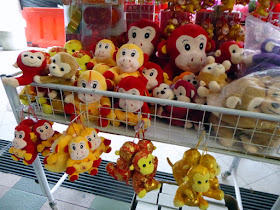In the old days, months before the Chinese New Year, the then Chin Choo Pa Sat (the original People's Park before the current People's Park Complex) would be abuzz with the ladies going to pick up their favourite cloth to make clothes for the new year. After the fire, the stalls selling the cloth shifted to the new Chin Choo Pa Sat (as it is still known today). It is now known in English as People's Park.
The medium of communication must have been mainly Cantonese as I remember, although I have met Teochews who could literally switch from one language to the other, adding in the flowery words in between without any pause. And indeed, one has to be careful when shopping. Don't get into serious bargain when you don't have the intention to buy, especially when the shop is just open. The first sale must be successful or the whole day would be ruined. Superstition? Perhaps. But certainly it would drain the mood away. For the skilful customers, it would be the best time to extract the best deal as the shopowner would want to succeed in that deal, even if it mean less profit.
The opening price and the agreed price can be at big extremes as the veteran shoppers will tell you. It is still happening in Nanyang! And if you were to reduce the asking price by 50%, and after a few lukewarm attempt, the shopowner agreed to sell you, you could have come away feeling that you have had it! :)
Looking from behind the front of the shop, I could understand why the asking price would be high. When these retailer bought the cloth from the wholesaler, they usually come in 5 colours of the same pattern. Out of these 5 colours, they would be lucky if two colours could sell, and not the other three. So, the shopowner had to balance to see how to recover costs, not to talk about profit.
In the much earlier days, there would be the black cloth (satin? silk? or what one in Hokkien called Kong Tuan) which would be favourite of the ladies to make pants. We were talking about ladies reaching 40 considering such less than colourful wear. In a way, maybe, when one moved towards being a granny, that's the shade of colours one would start trending towards. And there were the Majie who would be wearing such colours too.
For the younger ones, there would be the bright and colourful ones. More popular cloth would probably have come from Japan, mainly the synthetic ones.
Those were also the days when guys would buy cloth to make shirts. I was lucky to get cloth at no cost to make shirts. No thoughts of advertisements in those days.
Dating days also meant helping to man the shop. I was no good in doing sales. First, it is mainly in Cantonese. I am not good enough to chat, not to mention doing the to-ing and fro-ing in a match of patience and art of war. One has to convince the other, giving some technical knowledge on why this particular cloth was more costly, the made, and latest technologies. And so, I offered to do more of the closing of the shop at the end of the day. This is a man's shop, putting plank and plank that together covered up the shop front, leaving one space for the door. But hey, my mother-in-law did it on her own too, when we were not around, most of the time. Young people could be held down sitting in front of the shop and "king-gai" (chit chat).
The more tedious part must be the annual cleaning. This would happen like one or two weeks before the Chinese New Year. By then, no one would be buying any cloth as it would be too late to have it made in time for the new year. This would be the time when all the shops started closing down, cleaning the place and throwing away many things, most of the which could be the empty cloth paper roll. Cobwebs, dust and soot .. it would take a whole day to clean. And then, it would be closed for a good week or two, waiting for the auspicious day to start the new year's business.
My adventure with the cloth business ended when my Mother-in-Law passed on.






















